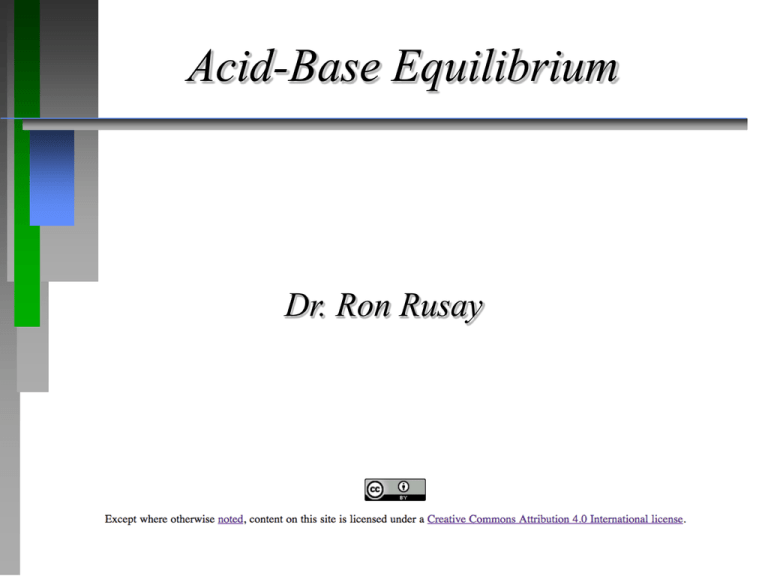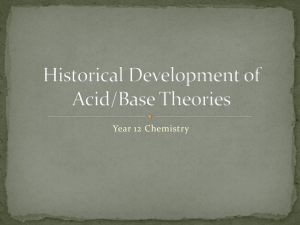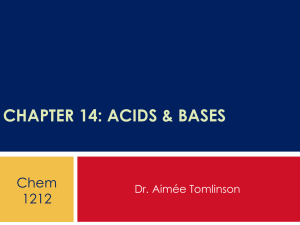Models of Acids and Bases
advertisement

Acid-Base Equilibrium Dr. Ron Rusay Introduction to Aqueous Acids Acids: taste sour and cause certain dyes to change color. Introduction to Aqueous Bases Bases: taste bitter, feel soapy and cause certain dyes to turn color. Models of Acids and Bases Acids produce H+ & bases produce OH ion in aqueous solutions . Brønsted-Lowry: Acids are H+ donors & bases are proton acceptors. Arrhenius: + H2O Cl + H3O+ acid base HCl Lewis Acids and Bases Lewis Acid: electron pair acceptor Lewis Base: electron pair donor Example: 3+ H H Al3+ + 6 O Al O H H 6 Lewis Acids and Bases The Mg2+ Ion is a Lewis Acid in the Chlorophyll Molecule; Fe2+ Ion is a Lewis Acid in normal Hemoglobin Conjugate Acid/Base Pairs HA(aq) + H2O(l) H3O+(aq) + A(aq) acid 1 conjugate base 2 conj acid 2 conj base 1 acid: formed when the proton is transferred to the base. conjugate base: everything that remains of the acid molecule after a proton is lost. http://chemconnections.org/general/movies/ConjugateAcidBaseActivity.swf Strong & Weak Acids: Dissociation Constant (Ka) HA(aq) Ka HA(aq) + H2O(l) H3O+(aq) + A (aq) H 3O HA A H H+(aq) + A (aq) A HA Acid Strength Strong Acid: Equilibrium position lies far to the right. (HNO3); Ka >> 1 Produces a conjugate base. (NO3) and a conjugate acid which are weaker than the starting acid and base (H2O). Acid Strength Strong Acids: Acid Strength (continued) Weak Acid: Equilibrium lies far to the left. (CH3COOH); Ka < 1 Yields a stronger (relatively strong) conjugate base than water. (CH3COO) Weak Acids Weak acids are only partially ionized in solution. H3O+(aq) + A-(aq) HA(aq) + H2O(l) HA(aq) [H 3O ][A- ] Ka [HA] H+(aq) + A-(aq) or [H ][A- ] Ka [HA] Ka is the acid dissociation constant. Percent Ionization Percent ionization is a way to assess relative acid strengths. For the reaction HA(aq) + H2O(l) % ionization H3O+(aq) + A-(aq) [H ]eqm [HA ]0 100 Percent ionization relates the H3O+ (aq) equilibrium concentration, [H+]eqm, to the initial HA(aq) concentration, [HA]0. The Extent of Dissociation for Strong and Weak Acids Weak Acids The higher percent ionization, the stronger the acid. Percent ionization of a weak acid decreases as the molarity of the solution increases. For acetic acid, 0.05 M solution is 2.0 % ionized whereas a 0.15 M solution is 1.0 % ionized. Weak Acids Percent Ionization QUESTION Nitric acid, HNO3, is considered to be a strong acid whereas nitrous acid, HNO2, is considered to be a weak acid. Which of the statements here is fully correct? A. Nitric acid has an aqueous equilibrium that lies far to the right and NO3– is considered a weak conjugate base. B. Nitric acid has a stronger conjugate base than nitrous acid. C. The dissociation of nitrous acid compared to an equal concentration of nitric acid produces more H+. D. The equilibrium of nitrous acid lies far to the left and the conjugate base is weaker than the conjugate base of nitric acid. Bases “Strong” and “weak” are used in the same sense for bases as for acids. Strong = complete dissociation, Kb >> 1 (concentration of hydroxide ion in solution) NaOH(s) Na+(aq) + OH (aq) NaOH(s) + H2O(l) Na+(aq) + OH (aq) Bases (continued) Weak bases have very little dissociation, Kb < 1 ( little ionization with water) CH3NH2(aq) + H2O(l) CH3NH3+(aq) + OH(aq) How conductive is NaOH(aq) vs morphine, C17H19NO3 (aq)? QUESTION Aniline, C6H5NH2, was isolated in the 1800s and began immediate use in the dye industry. What is the formula of the conjugate acid of this base? A. B. C. D. C6H5NH2+ C6H5NH3+ C6H5NH– C6H5NH+ Water as an Acid and a Base Self-ionization Water as an Acid and a Base H2O(l) + H2O(l) H3O+(aq) + OH-(aq) Water is amphoteric (it can behave either as an acid or a base). H2O + H2O H3O+ + OH acid 1 base 2 Kw conj conj acid 2 base 1 = 1 1014 at 25°C Water as an Acid and a Base Self-ionization http://chemconnections.org/general/movies/KwActivity.swf The pH Scale pH log[H+] log[H3O+] pH in water ranges from 0 to 14. Kw = 1.00 1014 = [H+] [OH] pKw = 14.00 = pH + pOH As pH rises, pOH falls (sum = 14.00). There are no theoretical limits on the values of pH or pOH. (e.g. pH of 2.0 M HCl is -0.301) The pH Values of Some Familiar Aqueous Solutions [H3O+] [OH-] = KW [H3O+] [OH-] [H3O+]> [OH-] [H3O+]< [OH-] acidic solution neutral solution basic solution [H3O+] = [OH-] QUESTION In a solution of water at a particular temperature the [H+] may be 1.2 10–6 M. What is the [OH–] in the same solution? Is the solution acidic, basic, or neutral? A. B. C. D. 1.2 10–20 M; acidic 1.2 10–20 M; basic 8.3 10–9 M; basic 8.3 10–9 M; acidic http://chemconnections.org/general/movies/pHEstimation.swf pH Estimation QUESTION An environmental chemist obtains a sample of rainwater near a large industrial city. The [H+] was determined to be 3.5 10–6 M. What is the pH, pOH, and [OH–] of the solution? A. B. C. D. pH = 5.46 ; pOH = 8.54; [OH–] = 7.0 10–6 M pH = 5.46 ; pOH = 8.54; [OH–] = 2.9 10–9 M pH = 12.56 ; pOH =1.44 ; [OH–] = 3.6 10–2 M pH = 8.54; pOH = 5.46; [OH–] = 2.9 10–9 M Name: ____________________ Partner (if any): ____________________ The pH Scale Indicators Acid-Base Indicators Titrations: Indicators & (pH) Curves pH Curve is a plot of pH of the solution being analyzed as a function of the amount of titrant added. Equivalence (stoichiometric) point: Enough titrant has been added to react exactly with the solution being analyzed. An indicator provides a visible color change to determine an (end point) volume of titrant. QUESTION Most acid-base indicators are weak acids. In a titration of 0.50 M acetic acid (at 25°C, Ka = 1.8 10–5) with KOH, which indicator would best indicate the pH at the equivalence point? The approximate Ka for each choice is provided. A. B. C. D. Bromophenol blue; Ka ~ 1 10–4 Methyl red; Ka ~ 1 10–5 Bromothymol blue; Ka ~ 1 10–7 Alizarin yellow; Ka ~ 1 10–10 Methods for Measuring the pH of an Aqueous Solution (a) pH paper (b) Electrodes of a pH meter QUESTION The acid-base indicator bromocresol purple has an interesting yellow-to-purple color change. If the approximate Ka of this indicator is 1.0 10–6, what would be the ratio of purple [A–] to yellow [HA] at a pH of 4.0? A. B. C. D. 100:1 1:100 1:1 This choice indicates that I don’t know. Conjugates Ka x Kb = ? http://chemconnections.org/general/movies/Ka-KbActivity.swf Conjugates Ka x Kb = Kw What do pKa and pKb refer to? pKa + pKb = ? pKa + pKb = pKw QUESTION Use information on this table to determine which of the following bases would have the weakest conjugate acid: OC6H5–; C2H3O2–; A. B. C. D. OC6H5– C2H3O2– OCl– NH3 OCl–; NH3 Strong vs.Weak Acids pH Estimations/ Calculations What are the respective pH values for a 0.100M solution of HCl (Ka = ) and a 0.100M solution of HF (Ka = 3.53 x 10-4)? What are the respective equilibrium concentrations of H+ (H3O+)? pH is calculated from the equilibrium concentration of H+ (H3O) Using Ka, and the starting molarity of acid, the equilibrium concentration of H+ (H3O+) can be estimated and then pH); Strong acids 100%, pH=1.00, Weak: less than 100% Strong vs.Weak Acids pH Estimations/ Calculations What are the respective pH values for a 0.100M solution of HCl (Ka = ) and a 0.100M solution of HF (Ka = 3.53 x 10-4)? Using Ka, and the starting molarity of the weak acid, the equilibrium concentration of H+ (H3O+) can be estimated using an ICE approach and then the pH. Ka = [H+][A–] / [HA – x] = x2/(0.100 M – x) 3.53 10–4 = x2/0.100; estimate @ x (10–5)1/2 representing the [H+], taking –log yields a pH >2 and <3. QUESTION Which of the following correctly compares strength of acids, pH, and concentrations? A. A weak acid, at the same concentration of a strong acid, will have a lower pH. B. A weak acid, at the same concentration of a strong acid, will have the same pH. C. A weak acid, at a high enough concentration more than a strong acid, could have a lower pH than the strong acid. D. A weak acid, at a concentration below a strong acid, could have a lower pH than a strong acid. Weak Acids Ka and Calculating pH Write the balanced chemical equation clearly showing the equilibrium. Write the equilibrium expression. Use the value for Ka Let x = [H+]; substitute into the equilibrium constant expression and solve. Convert [H+] to pH. Equilibrium Concentration Calculations pH from Initial Concentrations and Ka What is the pH value for a 0.100M solution of HF (Ka = 3.53 x 10-4)? H +(aq) + F - (aq) HF(aq) Ka = [H +] [F -] [HF] Equilibrium Concentration Calculations HF(aq) H +(aq) + F - (aq) Concentration (M) HF H+ F__________________________________________ Initial 0.100 0 0 Change 0.100-x +x +x Final 0.100-x x x Kc = [H +][F -]= 3.53 x 10 -4 = x2 [HF] (0.100 - x) 3.53 x 10 -4 (0.100 - x) = x2 Quadratic: 0 = x2 + 3.53 x 10 -4 x - 3.53 x 10 -5 x=[H +] = 0.00805 M; pH= 2.09 Simplified: 3.53 x 10 -4 = x2 (0.100 ) 3.53 x 10 -4 (0.100 ) = x2 x= [3.53 x 10 -4 (0.100 ) ]1/2 x=[H +] = 0.00594 M; pH= 2.23 QUESTION Butyric acid is a weak acid that can be found in spoiled butter. The compound has many uses in synthesizing other flavors. The Ka of HC4H7O2 at typical room temperatures is 1.5 10–5. What is the pH of a 0.20 M solution of the acid? A. B. C. D. 5.52 4.82 2.76 –0.70 QUESTION A 0.35 M solution of an unknown acid is brought into a lab. The pH of the solution is found to be 2.67. From this data, what is the Ka value of the acid? A. B. C. D. 6.1 10–3 1.3 10–5 7.5 10–4 2.1 10–3 Ka Values of Some Hydrated Metal Ions at 25oC Ion Fe3+ (aq) Sn2+ (aq) Cr3+ (aq) Al3+ (aq) Be2+ (aq) Cu2+ (aq) Pb2+ (aq) Zn2+ (aq) Co2+ (aq) Ni2+ (aq) Ka 6 x 10-3 4 x 10-4 1 x 10-4 1 x 10-5 4 x 10-6 3 x 10-8 3 x 10-8 1 x 10-9 2 x 10-10 1 x 10-10 Oxides Acidic OX Oxides (Acid Anhydrides): bond is strong and covalent. SO2, NO2, CrO3 Basic Oxides (Basic Anhydrides): OX bond is ionic. K2O, CaO Structure and Acid-Base Properties Two important factors that effect acidity in binary compounds, eg. HCl (aq): Bond Polarity (smaller e.n. differences favor higher acidities) Bond Strength (weak bonds favor higher acidity: more protons [hydronium ions] in solution) Select & explain which is the stronger acid: HBr vs. HF. http://chemconnections.org/general/movies/pHofSaltSolutions.swf QUESTION The following salts were all placed in separate solutions at the same temperature so that their concentrations were all equal. Arrange them in order from lowest pH to highest pH. NaCl; NH4NO3; Ca(C2H3O2)2; AlCl3 Additional information: Kb for NH3 = 1.8 10–5; Ka for HC2H3O2 = 1.8 10–5; Ka for Al(H2O)3+ = 1.4 10–5. A. B. C. D. NaCl; AlCl3; AlCl3; NH4NO3; NH4NO3; NaCl; NH4NO3; AlCl3; Ca(C2H3O2)2; NH4NO3; NaCl; NaCl; AlCl3 Ca(C2H3O2)2 Ca(C2H3O2)2 Ca(C2H3O2)2 Strength of Oxyacids Strength of Oxyacids Name the acids: , Ka = 2.1 x 10-8 HIO , Ka = 2.3 x 10-11 HClO , Ka = 3.0 x 10-8 HClO2 , Ka = 1.2 x 10-2 HBrO Is HBrO3 stronger or weaker than HClO3? A) stronger or B) weaker QUESTION Rank 1.0M solutions of HBrO, HIO and HClO in order of increasing acidity. HBrO , Ka = 2.1 x 10-8 HIO , Ka = 2.3 x 10-11 HClO , Ka = 3.0 x 10-8 A) HBrO < HIO < HClO B) HIO < HBrO < HClO C) HClO < HBrO < HIO D) HIO < HClO < HBrO QUESTION Rank 1.0M solutions of HBrO, HIO and HClO in order of increasing pH. HBrO , Ka = 2.1 x 10-8 HIO , Ka = 2.3 x 10-11 HClO , Ka = 3.0 x 10-8 A) HBrO < HIO < HClO B) HIO < HBrO < HClO C) HClO < HBrO < HIO D) HIO < HClO < HBrO Strength of Acids Strength of Acids Br-CH2COOH, I-CH2COOH, CH3COOH pKa=2.69 pKa=3.12 pKa=4.75 1) Is chloroacetic acid more or less acidic than bromoacetic acid? 2) Will its pKa be higher or lower than bromoacetic acid? A) 1.more 2.higher B) 1.less 2.lower C) 1.less 2.higher D) 1.more 2.lower QUESTION Rank the following acids in order of decreasing acidity. 1) Br-CH2COOH, 2) I-CH3COOH, 3) CH3COOH pKa= 2.69 pKa=3.12 pKa=4.75 A) 1 > 2 > 3 B) 3 > 2 > 1 C) 2 > 3 > 1 QUESTION Ascorbic acid, also known as vitamin C, has two hydrogen atoms that ionize from the acid. Ka1 = 7.9 10–5; Ka2 = 1.6 10–12. What is the pH, and C6H6O62– concentration of a 0.10 M solution of H2C6H6O6? A.2.55; [C6H6O62–] = 0.050 M B.2.55; [C6H6O62–] = 1.6 10–12 M C.1.00; [C6H6O62–] = 1.6 10–12 M D.5.10; [C6H6O62–] = 0.050 M Amino Acids More than 700 amino acids occur naturally, but 20 (22?) of them are especially important. These 20 amino acids are the building blocks of proteins in humans and developed organisms They differ in respect to the group attached to the a carbon. Why do you suppose they are written with + and – charges? O H + – H3N O C C R Amino Acids •Our bodies can synthesize about 10 amino acids. •Essential amino acids are the other 10 amino acids, which have to be ingested. •The a-carbon in all amino acids except glycine is chiral (has 4 different groups attached to it). •Chiral molecules exist as two non-superimposable mirror images called enantiomers. •L-amino acids are the common natural enantiomers. Amino Acids •L-amino acids are the common natural enantiomers, eg. Alanine above. Sickle Cell Anemia Normal hemoglobin vs sickle cell hemoglobin Sickle Cell Anemia Normal hemoglobin vs sickle cell hemoglobin Valine replaces Glutamate http://chemconnections.org/Presentations/Columbia/slide9-3.html Neutralization Reactions Would there be a difference in the reaction of HF versus HCl? Neutralizations / Titrations Are there differences in the titration of HF versus HCl? ….1) mass wise? …. 2) pH wise? A) 1.NO 2.NO B) 1.YES 2.YES C) 1.YES 2.NO D) 1.NO 2.YES Neutralizations / Titrations Are there differences in the titration of HF versus HCl? ….1) mass wise? …. 2) pH wise? QUESTION What is the pH of a solution made from adding 500. mL of 2.00 M HOAc(aq) (Ka = 1,8 x 10 -5) to 100. mL of 5.100M NaOH (aq) ? (This question relates to the titration of acetic acid.) A) 4.74 B) 4.76 C) 9.24 D) 9.26 QUESTION Most acid-base indicators are weak acids. In a titration of 0.50 M acetic acid (at 25°C, Ka = 1.8 10–5) with KOH, which indicator would best indicate the pH at the equivalence point? The approximate Ka for each choice is provided. A. B. C. D. Bromophenol blue; Ka ~ 1 10–4 Methyl red; Ka ~ 1 10–5 Bromothymol blue; Ka ~ 1 10–7 Alizarin yellow; Ka ~ 1 10–10 QUESTION The acid-base indicator bromocresol purple has an interesting yellow-to-purple color change. If the approximate Ka of this indicator is 1.0 10–6, what would be the ratio of purple [A–] to yellow [HA] at a pH of 4.0? A. B. C. D. 100:1 1:100 1:1 This choice indicates that I don’t know.









